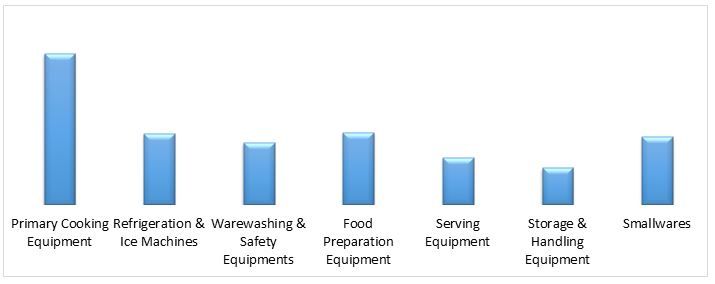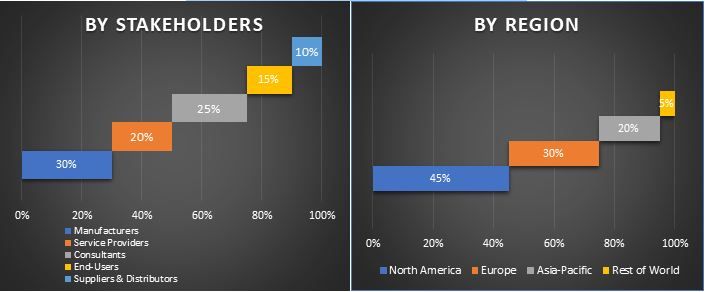- Home
- About Us
- Industry
- Services
- Reading
- Contact Us
Food Service Equipment Market: Current Analysis and Forecast (2021-2027)
Emphasis on Equipment Type (Cooking & Preparation Equipment, Refrigeration Equipment, Ware Washing Equipment, Storage & Handling Equipment, Others); Sales Channel (Online, Offline); End-Users (Full-Service Restaurant, Quick Service Restaurant, Hotels & Pub Bar Clubs, Others); and Region & Country

Equipment such as cooking, washing, storage, and handling equipment are used in the foodservice industry for the preparation and storage of food products for commercial purposes. Owing to the significant growth in the hospitality industry and increased use of temperature-optimized storage equipment for perishable food; the need for foodservice equipment worldwide is increasing. The increased per capita spending of consumers on food has inclined them towards online food delivery and restaurant dine-in. For instance, Japan has the highest per capita spending on food that is USD 4,417.5 per person followed by Australia, Canada, and France with per-person spending of USD 3,003.6, USD 2,986.9, and USD 2,983.4, respectively. This has led to the demand for foodservice equipment at restaurants, cafes, and hotels.
The number of hotels continues to grow, albeit at a moderate pace. The total number of hotels world’s population reached 1,84,299 by 2018, having added 14,252 hotels since 2008. This number is continuously increasing with the increase in demand for ready-to-eat food. With the significant increase in the total number of hotels worldwide the demand for installation of foodservice equipment such as cooking appliances, refrigerators, storage equipment, and other such equipment is also increasing and is expected to boost the market in the coming years. Furthermore, with the increase in employment population, the demand for ready-to-eat food has been subsequently increased. Owing to this the demand for full-service restaurants (FSR) and quick service restaurants (QSR) has also boosted. For instance, according to Organization for Economic Co-operation and development, in countries such as Japan, U.S.A, Canada, and the U.K., the female employment rates are valued at 67.5%, 64.9%, 70.6%, and 69.7% respectively.
The increase in employment rate along with the increased consumption of ready-to-eat food is driving the market for full-service restaurants.
Worldwide Food Service Equipment Budget, 2018
Welbilt, The Middleby Corporation, Standex International Corporation, ITW Food Equipment Group, Dover Corporation, Haier Inc., AB Electrolux, The Manitowoc Company, Inc., Ali Group S.R.L, and Duke Manufacturing, etc are some of the prominent players operating in the global Foodservice Equipment market. Several M&As along with partnerships have been undertaken by these players to facilitate customers with hi-tech and innovative products.
Insights Presented in the Report
“Amongst Equipment Type, Cooking & Preparation segment holds the major share”
Based on the Equipment Type, the market is fragmented into Cooking & Preparation Equipment, Refrigeration Equipment, Ware Washing Equipment, Storage & Handling Equipment, and Others. The cooking & preparation segment dominated the market with a share of XX% in 2020 and is expected to maintain its dominance during the forecast period owing to their demand for all types of restaurants, hotels; etc.
“Amongst Sales Channel, Offline is anticipated to grow at the highest CAGR during the analyzed period”
Based on the Sales Channel, the market is fragmented into Online and Offline. In 2020, offline accounted for a maximum market revenue share of XX% and is expected to remain dominant during the analyzed period. Through offline purchase, end-users can easily analyze the technical specification and functioning of the product, owing to this offline segment is anticipated to grow at the highest CAGR over the forecast period and reach a market evaluation of USD XX billion.
Amongst End-User, Full-Service Restaurant segment holds the major share”
Based on the End-Users, the market is fragmented into Full-Service Restaurant, Quick Service Restaurant, Hotels & Pub Bar Clubs, and Others. The full-service restaurants dominated the market in 2020 with revenue of USD XX billion and is anticipated to maintain its dominance during the analyzed period.
“North America signifies one of the largest markets of Food Service Equipment Market”
For a better understanding of the market dynamics of the Food Service Equipment Market, a detailed analysis was conducted for different regions across the globe including North America (United States, Canada, and the Rest of North America), Europe (Germany, France, Italy, Spain, United Kingdom and Rest of Europe), Asia-Pacific (China, Japan, India, Australia, and Rest of APAC), and Rest of World. Owing to the increased adoption of technologically advanced equipment, North America dominated the market and generated revenue of USD XX billion in 2020.
Reasons to buy this report:
- The study includes market sizing and forecasting analysis validated by authenticated key industry experts
- The report presents a quick review of overall industry performance at one glance
- The report covers an in-depth analysis of prominent industry peers with a primary focus on key business financials, product portfolio, expansion strategies, and recent developments
- Detailed examination of drivers, restraints, key trends, and opportunities prevailing in the industry
- The study comprehensively covers the market across different segments
- Deep dive regional level analysis of the industry
Customization Options:
Food Service Equipment Market can further be customized as per the requirement or any other market segment. Besides this, UMI understands that you may have your own business needs, hence feel free to connect with us to get a report that completely suits your requirements.
Table of Content
Analyzing the historical market, estimation of the current market, and forecasting the future market of the Global Food Service Equipment Market were the three major steps undertaken to create and analyze the adoption of Food Service Equipment for the different purposes across major regions globally. Exhaustive secondary research was conducted to collect the historical market numbers and estimate the current market size. Secondly, to validate these insights, numerous findings and assumptions were taken into consideration. Moreover, exhaustive primary interviews were also conducted, with industry experts across the value chain of the Food Service Equipment sector. Post assumption and validation of market numbers through primary interviews, we employed a top-down/bottom-up approach to forecast the complete market size. Thereafter, market breakdown and data triangulation methods were adopted to estimate and analyze the market size of segments and sub-segments the industry pertains to. Detailed methodology is explained below:
Analysis of Historical Market Size
Step 1: In-Depth Study of Secondary Sources:
Detailed secondary study was conducted to obtain the historical market size of the Food Service Equipment through company internal sources such as annual report & financial statements, performance presentations, press releases, etc., and external sources including journals, news & articles, government publications, competitor publications, sector reports, third-party database, and other credible publications.
Step 2: Market Segmentation:
After obtaining the historical market size of the Food Service Equipment, we conducted a detailed secondary analysis to gather historical market insights and share for different segments for major regions. Major segments included in the report are equipment type, sales channel, and end-user. Further country-level analyses were conducted to evaluate the overall adoption of Food Service Equipment in every region.
Step 3: Factor Analysis:
After acquiring the historical market size of different segments and sub-segments, we conducted a detailed factor analysis to estimate the current market size of Foodservice Equipment. Further, we conducted factor analysis using dependent and independent variables such as increasing demand for ready-to-eat food among the population. A thorough analysis was conducted for demand and supply-side scenarios considering top partnerships, merger and acquisition, business expansion, and product launches in the Food Service Equipment industry across the globe.
Current Market Size Estimate & Forecast
Current Market Sizing: Based on actionable insights from the above 3 steps, we arrived at the current market size, key players in the Food Service Equipment market, and market shares of the segments. All the required percentage shares split, and market breakdowns were determined using the above-mentioned secondary approach and were verified through primary interviews.
Estimation & Forecasting: For market estimation and forecast, weights were assigned to different factors including drivers & trends, restraints, and opportunities available for the stakeholders. After analyzing these factors, relevant forecasting techniques i.e. top-down/bottom-up approach was applied to arrive at the market forecast about 2027 for different segments and subsegments across the major markets globally. The research methodology adopted to estimate the market size encompasses:
- The industry’s market size, in terms of value (USD) and the adoption rate of Food Service Equipment across the major markets domestically
- All percentage shares, splits, and breakdowns of market segments and sub-segments
- Key players in the Foodservice Equipment market in terms of services offered. Also, the growth strategies adopted by these players to compete in the fast-growing market
Market Size and Share Validation
Primary Research: In-depth interviews were conducted with the Key Opinion Leaders (KOLs) including Top Level Executives (CXO/VPs, Sales Head, Marketing Head, Operational Head, and Regional Head, Country Head, etc.) across major regions. Primary research findings were then summarized, and statistical analysis was performed to prove the stated hypothesis. Inputs from primary research were consolidated with secondary findings, hence turning information into actionable insights.
Split of Primary Participants in Different Regions
Market Engineering
Data triangulation technique was employed to complete the overall market estimation and to arrive at precise statistical numbers of each segment and sub-segment of the Food Service Equipment Market. Data was split into several segments & sub-segments post studying various parameters and trends in the areas of equipment type, sales channel, and end-user of the Food Service Equipment Market.
Main Objective of the Food Service Equipment Market Study
The current & future market trends of Food Service Equipment were pinpointed in the study. Investors can gain strategic insights to base their discretion for investments from the qualitative and quantitative analysis performed in the study. Current and future market trends were determined the overall attractiveness of the market at a regional level, providing a platform for the industrial participant to exploit the untapped market to benefit as a first-mover advantage. Other quantitative goals of the studies include:
- Analyze the current and forecast market size of Food Service Equipment in terms of value (USD). Also, analyze the current and forecast market size of different segments and sub-segments
- Segments in the study include areas of equipment type, sales channel, and end-user
- Define and analysis of the regulatory framework for the Food Service Equipment industry
- Analyze the value chain involved with the presence of various intermediaries, along with analyzing customer and competitor behaviors of the industry
- Analyze the current and forecast market size of the Foodservice Equipment market for the major region
- Major regions studied in the report include North America (the United States and Canada), Europe (Germany, France, Italy, Spain, and United Kingdom), Asia-Pacific (China, Japan, India, and Australia), and the Rest of World
- Company profiles of the Foodservice Equipment market and the growth strategies adopted by the market players to sustain in the fast-growing market
- Deep dive regional level analysis of the industry
Related Reports
Customers who bought this item also bought












